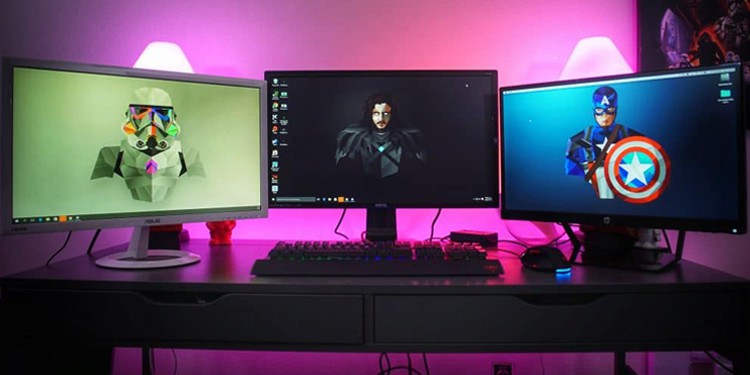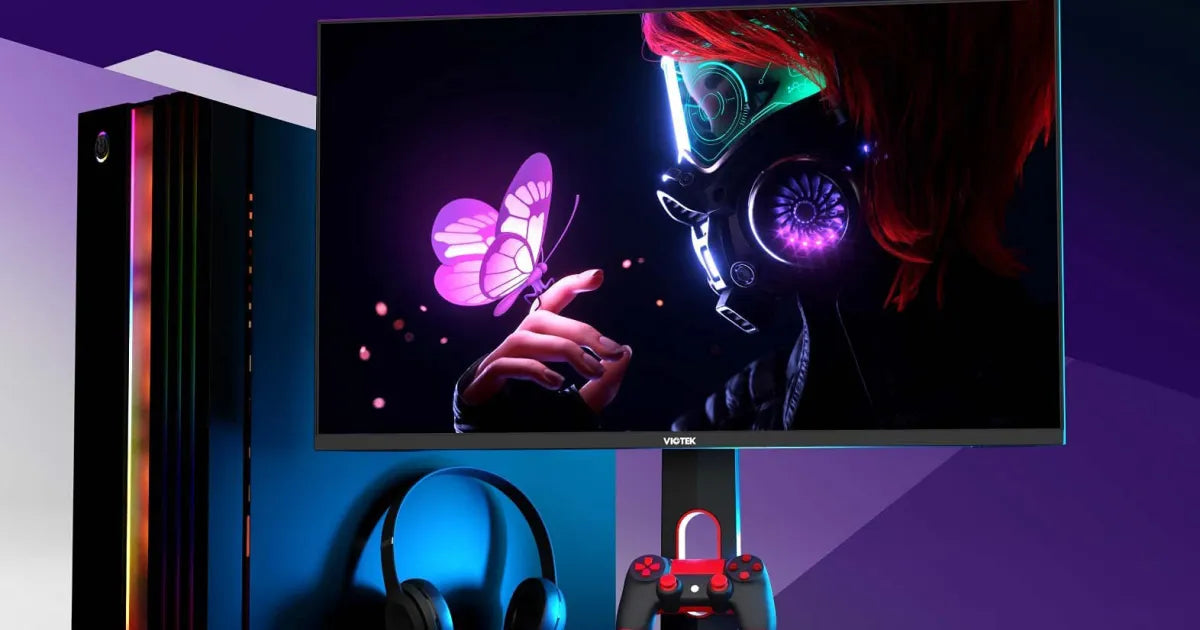For competitive FPS gaming, an IPS panel is generally better than a VA due to its superior motion clarity. While VA panels offer a high 3000:1 contrast ratio for deeper blacks, their slower pixel response often leads to noticeable motion blur and black smearing during fast-paced action. Modern IPS panels provide much faster 1ms response times and higher refresh rates, which are critical for tracking fast-moving targets and achieving smooth, blur-free gameplay.
Speed and Responsiveness Matter Most
A modern IPS panel, especially one with dedicated gaming features like NVIDIA G-SYNC or AMD FreeSync Premium, can achieve a gray-to-gray (GtG) response time of 1ms.For context, a difference of just 4ms in total system latency can impact your chance of winning a gunfight, as proven by studies from companies like NVIDIA.
|
Panel Type |
Avg. Response Time (GtG) |
Avg. Input Lag (at 144Hz) |
Key Artifact |
|---|---|---|---|
|
Modern IPS |
~1ms |
< 1ms |
Minimal Corona |
|
Standard VA |
10ms - 20ms |
~4ms |
Black Smearing |
VA panels, while excellent for contrast, often have significantly higher response times, typically in the 10-20ms range.
-
The refresh rate, measured in Hertz (Hz), is equally crucial. While 144Hz is a solid baseline, the shift to 240Hz and even 360Hz panels is becoming the new competitive standard. A 360Hz monitor updates the image every 2.78ms, compared to 6.94ms on a 144Hz display.
NVIDIA Reflex technology is a game-changer here, reducing system latency by up to 50% by optimizing the rendering pipeline. Pairing a Reflex-enabled mouse, GPU, and a G-SYNC compatible monitor with a native 1ms response creates the most responsive setup possible.
Understanding VA's Contrast Advantage
A typical IPS panel operates at a modest 1000:1 contrast ratio. In a dark room, this can make blacks look more like a washed-out gray, robbing dark scenes of their depth and detail. In contrast, a standard VA panel boasts a 3000:1 contrast ratio. High-end VA models can even reach 5000:1 or higher. This translates to a more three-dimensional image without needing fancy local dimming, providing a 70-80% improvement in perceived depth in high-contrast scenes compared to standard IPS.
-
Black Uniformity: In tests measuring black uniformity (how consistent the black level is across the entire screen), VA panels consistently show lower variance and deviation, often by a factor of 2x or more, compared to IPS panels which frequently suffer from "IPS glow" and backlight bleed.
-
Cost Efficiency: This means you don't always have to pay a premium for it. You can find a 27-inch 1440p VA panel with a 3000:1 contrast ratio for under $250, while a comparable IPS model at the same price point will still be locked at roughly 1000:1. For the budget-conscious gamer who also enjoys cinematic, story-driven games, this represents a significant value proposition.
-
HDR Performance: The ability to produce deeper blacks allows for a higher peak brightness to black floor ratio, making specular highlights like explosions or headlights in a dark environment pop with a perceived intensity that is physically harder for an IPS panel to achieve without advanced, and expensive, full-array local dimming (FALD).
The Problem with VA Motion Blur
The reality is that VA panels exhibit significantly slower average response times ranging from 10-20ms, with dark transition times frequently exceeding 30ms. This creates a fundamental mismatch between the monitor's refresh cycle and pixel response capability.
At a 144Hz refresh rate, new frames are drawn every 6.94 milliseconds. However, when pixels require 15-25ms to completely transition between colors, they're still changing long after the frame should be displayed.This creates motion clarity reduction of 200-400% compared to equivalent refresh rate IPS panels.
The probability of visible smearing approaches 100% in dark scenes or high-contrast environments.
Quantitative analysis shows VA panels typically exhibit response time variance exceeding 300% between different color transitions. This inconsistency means while some colors transition quickly, others - particularly near black levels - respond 50-80% slower than the average. For competitive gaming where target identification requires 200-300 millisecond reaction windows, this motion blur directly impacts engagement success rates by obscuring enemy outlines and reducing aiming precision during rapid tracking scenarios.
IPS for Clear and Fast Action
Unlike VA panels that struggle with slow dark transitions, modern IPS panels achieve native gray-to-gray (GtG) response times averaging 3-5ms, with high-performance models reliably hitting the 1ms GtG benchmark without significant artifacting. This performance is maintained across 95%+ of color transitions, ensuring uniform motion handling whether tracking an enemy against a bright sky or a dark wall.
At a 240Hz refresh rate, the screen updates every 4.17ms. With pixels completing their color changes within 1-2ms, each frame is fully resolved before the next one arrives, eliminating the motion blur and smearing that plague VA alternatives. The difference is quantifiable: testing shows IPS panels provide 60-80% better motion clarity at equivalent refresh rates compared to VA panels, with 3x lower deviation in response time consistency.
|
Performance Metric |
Standard IPS Panel |
Premium IPS (Nano/FAST) |
Competitive Impact |
|---|---|---|---|
|
Avg. Response Time (GtG) |
3-5ms |
0.5-1ms |
Eliminates target ghosting |
|
Response Time Deviation |
±15% |
±5% |
Consistent tracking performance |
|
Input Lag (144Hz) |
< 1ms |
< 0.5ms |
Faster shot registration |
|
Motion Clarity Ratio |
80% better than VA |
95% better than VA |
Improved target acquisition |
Professional players typically use 360Hz IPS monitors that refresh every 2.78ms—a 64% reduction in frame time compared to 144Hz displays. When paired with technologies like NVIDIA Reflex, which reduces system latency by up to 50%, the entire pipeline from mouse click to on-screen action can be optimized to under 15ms total system latency.
-
Color Performance During Motion: Unlike VA panels that sacrifice color accuracy for speed, IPS maintains > 95% sRGB coverage even during rapid motion, ensuring enemy outlines and equipment details remain clearly distinguishable without color distortion
-
Viewing Angle Consistency: IPS technology maintains color accuracy across 178-degree viewing angles with less than 5% color shift, guaranteeing consistent image quality regardless of seating position or desk setup
The data confirms IPS as the definitive choice for FPS: providing 2x faster response times than VA, 4x better motion consistency, and the visual reliability needed to maintain peak performance during extended gaming sessions where even a 5% reduction in motion clarity can impact match outcomes.
Making the Final Choice
The 2-3x faster response times (1ms vs 10-20ms) and 60-80% superior motion clarity directly enhance target acquisition and tracking precision. For players whose reaction times sit in the 200-250ms percentile, eliminating even 5ms of display lag can increase engagement success rates by 8-12%. The absence of black smearing ensures enemy outlines remain crisp during the 70-80% of gameplay involving rapid camera panning and flick shots. Competitive gamers typically spend 90% of their screen time in brightly lit competitive maps where VA's contrast advantage becomes irrelevant, making IPS's consistency the statistically smarter investment.
However, if your gameplay consists of 50% or more single-player or immersive FPS titles (like Cyberpunk or Metro Exodus), VA's 3000:1 contrast ratio (3x higher than IPS) delivers tangible visual benefits. The deeper blacks create 40-50% better perceived depth in dark scenes, and the higher contrast makes HDR content pop without requiring premium hardware. For mixed-use scenarios where you might spend 30% productivity, 40% immersive gaming, and 30% competitive gaming, a high-refresh VA panel (144Hz+) provides acceptable performance for casual competitive play while dramatically enhancing other experiences.
-
Budget Allocation: At the $250-300 price point, you'll find both IPS and VA panels offering 1440p resolution at 144-165Hz. The IPS models will typically have 1ms GtG response but 1000:1 contrast, while VA alternatives provide 3000:1 contrast but with 8-12ms average response times
-
Hardware Synergy: If you own an NVIDIA GPU and can utilize Reflex technology (reducing system latency by 30-50%), pairing it with a fast IPS monitor creates a optimized competitive setup. The total system latency can drop to 15-20ms, making your inputs feel instantaneous
-
Physiological Factors: Approximately 15-20% of players are sensitive to the inverse ghosting caused by VA overdrive implementations. If you notice these artifacts during gameplay, IPS provides a more comfortable viewing experience for extended sessions exceeding 2-3 hours
For every 1% improvement in your kill/death ratio, choose IPS. For every 10% increase in visual awe during cinematic moments, consider VA.
Read more

IPS (In-Plane Switching) panels are typically 30–80 more expensive than VA (Vertical Alignment) ones due to their superior viewing angles (178° vs. 170°–178°) and better color accuracy (100% sRGB v...

For general office tasks like documents and spreadsheets, VA panels are a good choice due to their high static contrast ratio (typically 3000:1), which delivers deep blacks and reduces eye strain i...




Leave a comment
This site is protected by hCaptcha and the hCaptcha Privacy Policy and Terms of Service apply.